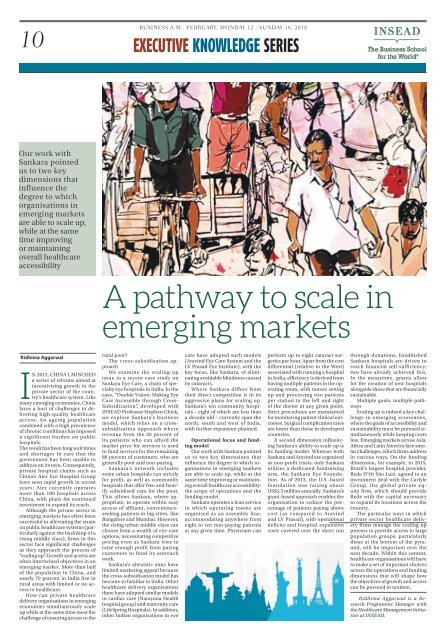12-02-2018
Create successful ePaper yourself
Turn your PDF publications into a flip-book with our unique Google optimized e-Paper software.
10<br />
BUSINESS A.M. FEBRUARY, MONDAY <strong>12</strong> - SUNDAY 18, <strong>2018</strong><br />
EXECUTIVE KNOWLEDGE SERIES<br />
Our work with<br />
Sankara pointed<br />
us to two key<br />
dimensions that<br />
influence the<br />
degree to which<br />
organisations in<br />
emerging markets<br />
are able to scale up,<br />
while at the same<br />
time improving<br />
or maintaining<br />
overall healthcare<br />
accessibility<br />
A pathway to scale in<br />
emerging markets<br />
Ridhima Aggarwal<br />
IN 20<strong>12</strong>, CHINA LAUNCHED<br />
a series of reforms aimed at<br />
incentivising growth in the<br />
private sector of the country’s<br />
healthcare system. Like<br />
many emerging economies, China<br />
faces a host of challenges in delivering<br />
high-quality healthcare<br />
access. An ageing population<br />
combined with a high prevalence<br />
of chronic conditions has imposed<br />
a significant burden on public<br />
hospitals.<br />
The result has been long wait times<br />
and shortages in care that the<br />
government has been unable to<br />
address on its own. Consequently,<br />
private hospital chains such as<br />
China’s Aier Eye Hospital Group<br />
have seen rapid growth in recent<br />
years: Aier currently operates<br />
more than 100 hospitals across<br />
China, with plans for continued<br />
investment to expand its reach.<br />
Although the private sector in<br />
emerging markets has often been<br />
successful in alleviating the strain<br />
on public healthcare systems (particularly<br />
against the backdrop of a<br />
rising middle class), firms in this<br />
sector face significant challenges<br />
as they approach the process of<br />
“scaling up”. Growth and access are<br />
often intertwined objectives in an<br />
emerging market: More than half<br />
of the population in China, and<br />
nearly 70 percent in India live in<br />
rural areas with limited or no access<br />
to healthcare.<br />
How can private healthcare<br />
delivery organisations in emerging<br />
economies simultaneously scale<br />
up while at the same time meet the<br />
challenge of ensuring access to the<br />
rural poor?<br />
The cross-subsidisation approach<br />
We examine the scaling-up<br />
issue in a recent case study on<br />
Sankara Eye Care, a chain of specialty<br />
eye hospitals in India. In the<br />
case, “Double Vision: Making Eye<br />
Care Accessible through Cross-<br />
Subsidization”, developed with<br />
INSEAD Professor Stephen Chick,<br />
we explore Sankara’s business<br />
model, which relies on a crosssubsidisation<br />
approach where<br />
revenue from the 20 percent of<br />
its patients who can afford the<br />
market price for services is used<br />
to fund services for the remaining<br />
80 percent of customers, who are<br />
generally poor and non-paying.<br />
Sankara’s network includes<br />
some urban hospitals run strictly<br />
for profit, as well as community<br />
hospitals that offer free and heavily<br />
subsidised care for the poor.<br />
This allows Sankara, where appropriate,<br />
to operate within easy<br />
access of affluent, convenienceseeking<br />
patients in big cities, like<br />
Bangalore and Mumbai. However,<br />
the rising urban middle class can<br />
choose from a wealth of eye-care<br />
options, necessitating competitive<br />
pricing even as Sankara tries to<br />
raise enough profit from paying<br />
customers to fund its outreach<br />
work.<br />
Sankara’s altruistic aims have<br />
limited marketing appeal because<br />
the cross-subsidisation model has<br />
become so familiar in India. Other<br />
healthcare delivery organisations<br />
there have adopted similar models<br />
in cardiac care (Narayana Health<br />
hospital group) and maternity care<br />
(LifeSpring Hospitals). In addition,<br />
other Indian organisations in eye<br />
care have adopted such models<br />
(Aravind Eye Care System and the<br />
LV Prasad Eye Institute), with the<br />
key focus, like Sankara, of eliminating<br />
avoidable blindness caused<br />
by cataracts.<br />
Where Sankara differs from<br />
their direct competition is in its<br />
aggressive plans for scaling up.<br />
Sankara’s ten community hospitals<br />
– eight of which are less than<br />
a decade old – currently span the<br />
north, south and west of India,<br />
with further expansion planned.<br />
Operational focus and funding<br />
model<br />
Our work with Sankara pointed<br />
us to two key dimensions that<br />
influence the degree to which organisations<br />
in emerging markets<br />
are able to scale up, while at the<br />
same time improving or maintaining<br />
overall healthcare accessibility:<br />
the scope of operations and the<br />
funding model.<br />
Sankara operates a lean service<br />
in which operating rooms are<br />
organised as an assembly line,<br />
accommodating anywhere from<br />
eight to ten non-paying patients<br />
at any given time. Physicians can<br />
perform up to eight cataract surgeries<br />
per hour. Apart from the cost<br />
differential (relative to the West)<br />
associated with running a hospital<br />
in India, efficiency is derived from<br />
having multiple patients in the operating<br />
room, with nurses setting<br />
up and processing two patients<br />
per station to the left and right<br />
of the doctor at any given point.<br />
Strict procedures are maintained<br />
for monitoring patient clinical outcomes.<br />
Surgical complication rates<br />
are lower than those in developed<br />
countries.<br />
A second dimension influencing<br />
Sankara’s ability to scale up is<br />
its funding model. Whereas both<br />
Sankara and Aravind are organised<br />
as non-profit trusts, only Sankara<br />
utilises a dedicated fundraising<br />
arm, the Sankara Eye Foundation.<br />
As of 2013, the U.S.-based<br />
foundation was raising about<br />
US$3.5 million annually. Sankara’s<br />
grant-based approach enables the<br />
organisation to reduce the percentage<br />
of patients paying above<br />
cost (as compared to Aravind<br />
and LV Prasad), with operational<br />
deficits and hospital expansion<br />
costs covered over the short run<br />
through donations. Established<br />
Sankara hospitals are driven to<br />
reach financial self-sufficiency;<br />
two have already achieved this.<br />
In the meantime, grants allow<br />
for the creation of new hospitals<br />
alongside those that are financially<br />
sustainable.<br />
Multiple goals, multiple pathways<br />
Scaling up is indeed a key challenge<br />
in emerging economies,<br />
where the goals of accessibility and<br />
sustainability must be pursued simultaneously<br />
while keeping costs<br />
low. Emerging markets across Asia,<br />
Africa and Latin America face similar<br />
challenges, which firms address<br />
in various ways. On the funding<br />
dimension, for example, in 2015,<br />
Brazil’s largest hospital provider,<br />
Rede D’Or São Luiz, agreed to an<br />
investment deal with the Carlyle<br />
Group, the global private equity<br />
firm, which should provide<br />
Rede with the capital necessary<br />
to expand its locations across the<br />
country.<br />
The particular ways in which<br />
private sector healthcare delivery<br />
firms manage the scaling-up<br />
process to provide access to large<br />
population groups, particularly<br />
those at the bottom of the pyramid,<br />
will be important over the<br />
next decade. Within this context,<br />
healthcare organisations will have<br />
to make a set of important choices<br />
across the operations and funding<br />
dimensions that will shape how<br />
the objectives of growth and access<br />
can be pursued in tandem.<br />
Ridhima Aggarwal is a Research<br />
Programme Manager with<br />
the Healthcare Management Initiative<br />
at INSEAD.










